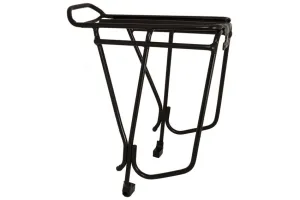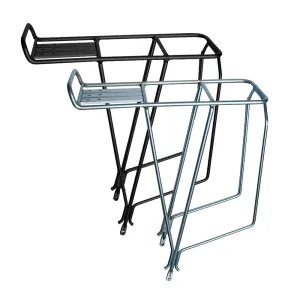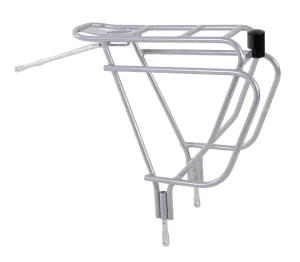Rear Racks
Rear racks for bikes are a versatile and practical accessory designed to enhance the carrying capacity and utility of a bicycle. It is typically attached to the rear of the bike frame, just above the rear wheel. Rear racks provide a stable platform for transporting various items, making them an essential component for commuting, touring, grocery shopping, and other cycling activities.
READ MORE...Key features and aspects of rear racks for bikes include:
Mounting: Rear racks are attached to the bike frame using various mounting systems, such as seat stay mounts, frame eyelets, and quick-release mechanisms. This ensures secure and stable installation, allowing the rack to support the weight of the cargo without affecting the bike’s stability.
Materials: Rear racks are constructed from a variety of materials, including aluminium, steel, and even lightweight alloys. The choice of material impacts the rack’s overall weight, durability, and load-bearing capacity.
Load Capacity: Rear racks come in different weight capacities, ranging from around 20 to 50 kilograms (44 to 110 pounds) or more. Choosing a rack with an appropriate load capacity ensures that you can safely carry your desired cargo without risking damage to the rack or compromising bike handling.
Design: Rear rack designs vary, with options for different bike types, such as road bikes, mountain bikes, and touring bikes. Some racks have a platform design with side rails, while others feature pannier hooks or mounting points for attaching bags, baskets, and other storage solutions.
Pannier Compatibility: Many rear racks are compatible with pannier bags, which are specially designed bags that attach to the sides of the rack. Panniers offer a convenient way to carry items while distributing the weight evenly for improved stability.
Adjustability: Some rear racks offer adjustable features, such as height adjustment, to accommodate different frame sizes, tire sizes, and bike geometries.
Accessories: Some rear racks come with integrated accessories, such as reflectors, lights, or attachment points for additional accessories like fenders.
Installation: Installing a rear rack may require basic mechanical skills and tools. Many racks include detailed instructions for proper installation, and some bike shops offer professional installation services.
Versatility: Rear racks are suitable for a wide range of applications, from daily commuting and grocery shopping to long-distance touring and bikepacking. They provide a convenient way to carry items without the need for a separate trailer or backpack.
Considerations: When selecting a rear rack, factors such as the type of bike, intended use, load capacity, and compatibility with other accessories should be taken into account. It’s important to ensure that the chosen rack is compatible with your bike’s frame and tire size.
Rear bike racks are valuable additions that expand the practicality and functionality of bicycles, allowing riders to carry cargo with ease and convenience. Whether you’re running errands around town or embarking on a cross-country adventure, a well-designed rear rack can greatly enhance your cycling experience.






